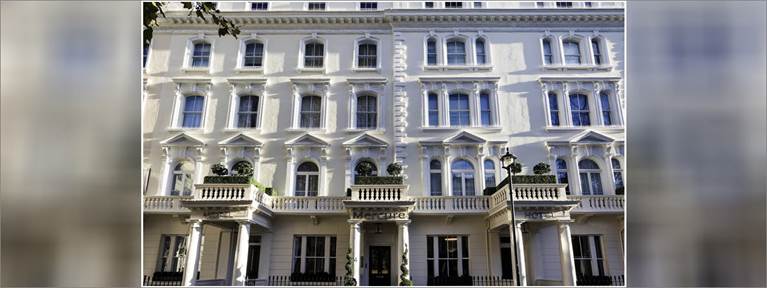The History of Mercure London Hyde Park Hotel
If you are looking for a hotel that combines modern comfort with historic charm, you might want to consider Mercure London Hyde Park Hotel. This boutique hotel is located in a peaceful garden square near Paddington Station, on the cusp of the iconic Hyde Park. But did you know that this hotel has a rich and fascinating history that dates back to the 19th century?
The Building's Origins
The hotel occupies a Grade II listed building that was first built in 1860 as a row of townhouses. The building was designed by John Johnson, a prominent architect who also worked on the Royal Albert Hall and Alexandra Palace. The townhouses were originally intended for wealthy families who wanted to enjoy the fashionable West End of London.
The building has many features that reflect the Victorian style and taste, such as high ceilings, large windows, ornate cornices and fireplaces. Some of these features have been preserved and restored in the hotel's rooms and suites, giving them a warm and elegant feel.
The People Who Lived There
One of the most notable residents of the building was Sir William Henry Perkin, a famous chemist who discovered the first synthetic dye, mauveine, in 1856. He lived at number 14 Talbot Square from 1863 to 1874, and conducted some of his experiments in his home laboratory. He also hosted many distinguished guests, such as Charles Darwin, Michael Faraday and Thomas Henry Huxley.
Another interesting resident was Lady Violet Bonham Carter, a political activist and writer who was the daughter of Herbert Asquith, the Prime Minister of the United Kingdom from 1908 to 1916. She lived at number 8 Talbot Square from 1916 to 1923, and was involved in various causes, such as women's suffrage, civil liberties and international peace. She was also a close friend of Winston Churchill and wrote a biography of him.
The Building's Transformation
The building underwent several changes over the years, as it adapted to different needs and demands. In 1890, it was converted into a boarding house for travellers and tourists who wanted to stay near Hyde Park and Paddington Station. In 1914, it became a hospital for wounded soldiers during World War I. In 1939, it was requisitioned by the government for military use during World War II.
In 1945, it was returned to civilian use and became a hotel again. It changed its name several times, such as The Talbot Hotel, The Norfolk Plaza Hotel and The Quality Crown Hotel. In 2016, it was renovated into a boutique hotel and rebranded as Mercure London Hyde Park Hotel.
The Hotel's Features
Today, the hotel offers 72 well-appointed guest rooms and suites that blend traditional charm with modern technology. Each room has a voice-controlled AI concierge that provides entertainment, property services and room service. Guests can also enjoy an on-site bar, restaurant and gym.
The hotel is also committed to sustainability and social responsibility. It has taken significant steps to reduce its environmental impact, such as using LED lighting, recycling waste and providing eco-friendly toiletries. It is also a proud certified property by Travel Proud, which means it welcomes all guests regardless of their sexual orientation or gender identity.
The Area's History
The hotel is not only surrounded by history within its walls, but also outside in its neighbourhood. The area where the hotel is located has a long and diverse history that spans centuries and cultures.
One of the most prominent landmarks near the hotel is Hyde Park, one of the largest and most famous parks in London. Hyde Park was established by Henry VIII in 1536 as a hunting ground for deer and wild boar. It later became a popular place for public events and demonstrations, such as fairs, concerts, protests and speeches.
One of the most famous spots in Hyde Park is Speakers' Corner, where anyone can speak freely on any topic they choose. Speakers' Corner was inaugurated in 1872 by an act of parliament that set aside a small part of Hyde Park explicitly for the use of public speaking. Since then, it has attracted many famous speakers, such as Karl Marx, George Orwell, Mahatma Gandhi and Malcolm X.
Another interesting aspect of the area's history is its connection to the birth of the movie industry and the first films. In 1896, the Lumière brothers, who are considered the inventors of cinema, held their first public screening of moving pictures in London at the Regent Street Polytechnic, which is now part of the University of Westminster. The screening was attended by about 50 people, who were amazed by the images of workers leaving a factory, a train arriving at a station and a baby being fed.
The following year, Robert W. Paul, a British pioneer of film, opened his Animatograph Works in Hatton Garden, near the hotel. He produced and exhibited many films, such as The Derby (1896), which was the first film to show a sporting event, and The Haunted Curiosity Shop (1901), which was one of the first horror films. He also invented many devices and techniques that improved film production and projection, such as the kinetoscope, the projector and the reverse motion.
Conclusion
Mercure London Hyde Park Hotel is more than just a place to stay. It is a place to experience history and culture, both inside and outside its doors. Whether you are interested in science, politics, art or entertainment, you will find something to inspire you in this hotel and its neighbourhood. Book your stay today and discover the history of Mercure London Hyde Park Hotel for yourself.
Book Now